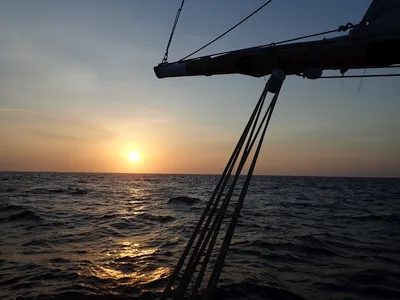Programs Blog
Living in “The Sea Around Us”

Ship’s Log
Noon Position
29° 14.4’N x 79° 11.5’W
Ship Heading
269.0°
Ship Speed
2.70 knots
Taffrail Log
1224 nm
Weather / Wind / Sail Plan
Sailing under a port tack under the mains’l, mainstays’l, forstays’l, jib, and JT. Wind is SE Beaufort force 3, sea direction is SE and sea height is 1 ft, visibility is 5 to 10 nm.
Description of location
103 nm E x N of Daytona Beach, FL
Every evening, the sun sets and the moon rises. Usually, this cycle is happening in the background of our lives, so disconnected from our day to day routines. We follow their pattern and allow it to dictate our sleep cycles, when we eat, and the hours we work. Yet, so rarely are we face to face with the sun, the moon, the stars, and everything in between. One of those rare occasions is our current reality on the Cramer.
We are so vividly connected to the world around us here in the middle of the ocean, and it has heightened my curiosity for almost everything. For oceanography class this week, we read an excerpt from Rachel Carson’s book, “The Sea Around Us” that just about summarized how I’m feeling right now. She mentions that you could sail for days on end and not see anything or any form of life at all, but if you tow a net along the surface, you will find life scattered all over.
I guess you could say our trip was inspired by that idea. As we deploy Neuston nets and surface stations every morning, we are reminded of the life that is all around us. Every time we do science deployments or process data, we are learning so much about the water right below our ship. Whether it be analyzing pH from a surface station or counting zooplankton in a 100 count, each data point we plot on our cruise track tells the story of the oceans we have sailed through. The story of C-297 is definitely one you will want to read. Our days here on Cramer are marked by number of dolphins seen, and sails raised. Nights aboard are recalled by hours on the helm, and shooting stars above.
As we don’t quite live the typical 9 to 5, our schedules are dictated by the triangle ringing for meal time and personalized wake ups. In between all the many hours of sleep we try to fit in, we also stand watch. I am constantly amazed at how we are able to fit a whole day in 24 hours, when sometimes it feels like 20 minutes, and other times 100 hours. The past few days have felt like minutes flying by, as so much has been changing onboard. We just recently switched watch officers and are now moving on to our next phase, the shadow phase.We are now taking on more responsibility on watch and learning so much more about what goes on inside the heads of our mates and scientists. Yesterday’s dawn watch was our first morning with our new watch officers, Rocky (1st Mate) and Corinna (3rd Scientist).
I shadowed Rocky (1st Mate) for part of our watch and I was in charge of making sure our watch rotations went smoothly. I’m relieved to say it all went smoothly and every member of B watch made it through morning to see the sunrise. Last night’s evening watch was just as eventful, as everything is more exciting in the dark. I was in lab, and once again it was my turn to be the shadow. I followed Corinna (3rd Scientist) around for then night as we prepped to deploy the Neuston net, which was quickly interrupted by a call from deck to take in the JT and the jib. Leanna was calling the maneuvers as the rest of B Watch hauled away under the stars. Our next move was a climb out on the headrig, where we prepared to furl with only the red glow of our headlamps. As we bopped along to the beat of the bow bouncing in the swells below, our systematic folds slowly faded into the night. Not long after our foresails were tucked in for the night, it was already time to wake up C watch for their morning dawn watch.
To my family: I love you and miss you all so much!! I can’t wait to talk to you soon and tell you everything. Give Casey a big hug for me!
– Cam Ragland, B Watch, Union College
Recent Posts from the Ships
- Ocean Classroom 2024-A collaborative high school program with Proctor Academy
- Collaborations and Long-term Commitments: SEA’s Caribbean Reef Program Sets a Course for Coastal Programs that Compliment Shipboard Experiences.
- Sea Education Association students prepare for life underway using state of the art nautical simulation from Wartsila Corporation.
- SEA Writer 2022, Magazines From the Summer SEA Quest Students
- Technology@SEA: Upgrades Allow Insight into Ocean Depths
Programs
- Gap Year
- Ocean Exploration
- High School
- Science at SEA
- SEA Expedition
- SEAScape
- Pre-College
- Proctor Ocean Classroom
- Protecting the Phoenix Islands
- SPICE
- Stanford@SEA
- Undergraduate
- Climate and Society
- Climate Change and Coastal Resilience
- Coral Reef Conservation
- Marine Biodiversity and Conservation
- MBL
- Ocean Exploration: Plastics
- Ocean Policy: Marine Protected Areas
- Oceans and Climate
- Pacific Reef Expedition
- The Global Ocean: Hawai'i
- The Global Ocean: New Zealand